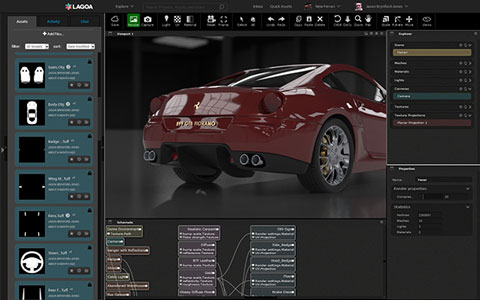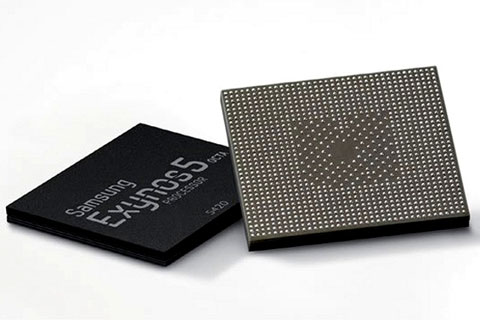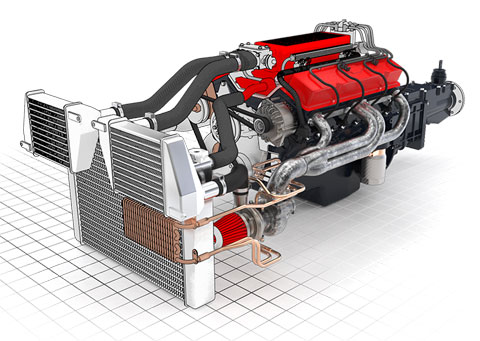
Lagoa is a brand new rendering engine built specifically for the cloud
In the real world renderers anonymously chug away in the background. At SIGGRAPH they are rock stars.
A strong ARM attack
In the GPU race, one company staking its claim among NVIDIA, AMD and Intel is ARM out of Cambridge, UK.
ARM is best known for its embedded CPUs in hand-held devices. Its news at SIGGRAPH 2013 is that the new Samsung Exynos 5 Octa 5420 chip features ARM’s six-core Mali T628 GPU. A Samsung representative showed the GPU running the GL Benchmark 2.7 at 15 frames per second, evidently very fast judging by his enthusiasm. For those who geek-out on these types of numbers, check out the engadget.com report here.
While that performance could be impressive to gamers, what value might ARM’s GPUs have for design and engineering applications?
They could be significant at two levels: One is the potential to use tablets and phones as cheap design review and simulation display devices. The other is that the low-power consumption for which ARM is known is becoming increasingly important at all levels of computing, including the upper-most echelons.
ARM’s Jem Davies, VP of technology for the media processing division, believes that the mobile market is at the center of technology innovation. But, he also thinks that mobile innovation “trickles down to other markets,” including supercomputers and servers.

Samsung Exynos 5 Octa 5420 chip features ARM’s six-core Mali T628 GPU.
It seems strange to apply the term “trickle down” to innovation migrating from embedded systems in tablets to high-performance computing systems, but that is precisely what ARM has in mind. Case in point is the use of Samsung Exynos chips by the Barcelona Supercomputing Center.
“Graphics is the poster boy for parallelization,” says Davies, and ARM has shown success in highly parallelized computing environments. The company’s greater presence at SIGGRAPH is more than a curiosity; it signals an attack at every level of the graphics computing market.
Purpose-built cloud rendering
Cloud rendering has been around for a few years, but mostly it has to do with established companies adapting existing technologies to the ephemeral cloud. Lagoa has a different approach, according to Chris Williams, the company’s VP of sales and marketing.
Williams says that Lagoa is the first new rendering engine built specifically for the cloud. The company’s founders have varied backgrounds: one built multi-physics rendering engines for Autodesk, another headed up rendering for fashion and consumer goods companies, and a third has expertise in back-end server technology.
Lagoa offers a range of per-user pricing plans and licenses out its technology and services for specialized rendering applications. Besides a render-anywhere ethos, its strengths appear to be simplicity and collaboration.
The Lagoa interface is easy-to-understand and use, and runs efficiently on browsers, making it convenient for different members of a design team to work together tweaking materials and lighting, then viewing the results in nearly real time.
Knowing the process
Simplicity has always been a hallmark of the KeyShot rendering system from Luxion. The company has done a superb job of adding features while maintaining a clean and elegant user interface.
At SIGGRAPH 2013, Luxion announced a new level of integration between KeyShot and Pixologic ZBrush. The advanced integration gives ZBrush users the ability to import and update their work inside KeyShot while retaining all textures.
Luxion’s latest version of KeyShot is 4.1, released only about five months after 4.0. Here is a list of new features in both releases. One of the more intriguing is something called toon shading – the ability to apply very simple shading immediately to a model. This simple approach gives designers a good idea about what a design will look like at the very beginning of the product development process.
What toon shading demonstrates is Luxion’s understanding of the product-development process – what is desired by designers and marketers at what stages. With several years in the business and good listening abilities, Luxion has the foundation to be a major player in the rendering market for years to come.

KeyShot’s new toon shader allows you to apply solid colors, solid shading and contours to your objects for a flat, cel shading appearance.
Better products through collaboration
Another company that seems to understand process and the value of collaboration is The Foundry, which announced a partnership that bundles its Katana lighting system with Pixar Renderman.
The Foundry’s Shane Griffith, formerly of Autodesk’s Media & Entertainment business, acknowledges the value of close partner relationships. He refers to the company’s design market as “CAD to ad” – extending from concept design to posters, brochures, catalogs, web commerce and other marketing assets. The glue in this process is The Foundry’s Modo modelling system.
Griffith assesses Modo’s strengths as sub-divisional modeling – a hybrid of NURBS and polygonal modeling with intelligent smoothing and sculpting – and the ability to handle very high-resolution images on lower-end systems.
Open for innovation and adaptation
Unlike some other computing technologies, rendering is not dominated by one or two vendors. It remains a cauldron of innovation, with new entrants offering intriguing possibilities and more-established vendors continuing to improve their products the old-fashioned way – by listening to their customers and adapting quickly to ever-changing market needs.
The author of this post, Bob Cramblitt, writes about design, engineering and manufacturing technologies that change the way products are developed, tested and marketed. He can be reached at info@cramco.com






